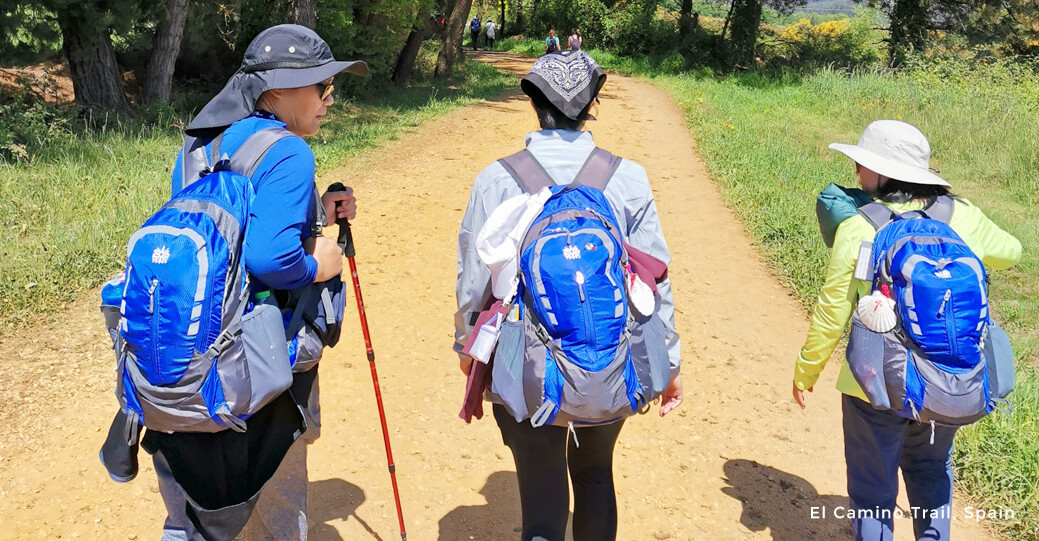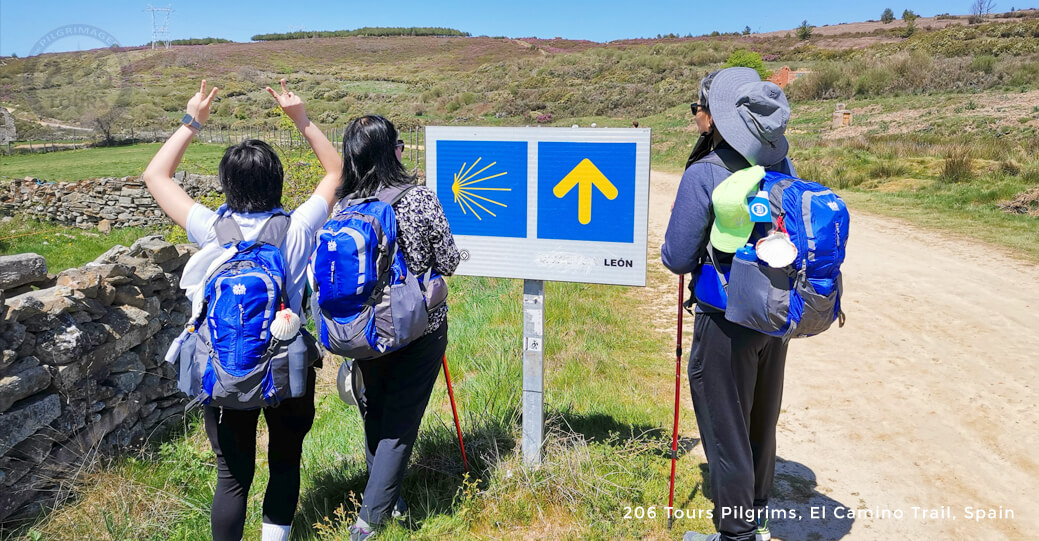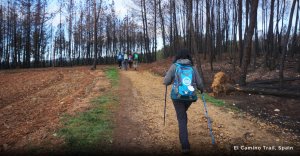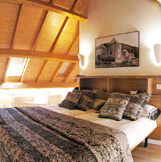Your trip includes
- Round-trip airfare from your desired Airport
- All airport taxes & fuel surcharges
- Hotel accommodations: (or similar) in double occupancy
- ~ 1 night: Hotel Central, St. Jean Pied de Port
- ~ 2 nights: Hotel Roncesvalles, Roncesvalles
- ~ 1 night: Hotel Tres Reyes, Pamplona
- ~ 1 night: Hotel El Cerco, Puente la Reina
- ~ 2 nights: Hospederia Chapitel, Estella
- ~ 2 nights: Hotel NH Logroño, Logroño
- ~ 1 night: Parador de Santo Domingo de la Calzad, Santo Domingo de la Calzada
- ~ 1 night: Preciados or Madrid: Hotel Preciados, Madrid, Spain
- Breakfast daily
- 9 Lunches
- Dinner Daily
- Wine and mineral water with dinners
- Transfers by air-conditioned coach or minibus
- Free WiFi & Water on bus
- Vehicle available to assist pilgrims who are unable to complete any leg of the tour
- Tour Escort throughout
- Local guide in Pamplona
- Daily Maps
- Transfers as per itinerary
- Catholic Priest to accompany the group
- Catholic Priest, Mass daily & Spiritual activities
El Camino Accommodations:
Please be advised that we book you in the best available accommodations that are along the Camino trail. There are a limited number of places to stay along the Camino trail, without having to walk extra miles away from the Trail, and then back to the Trail to continue walking the route. These places range in Star Rating – simply because luxury hotels just do not exist.
While you will be removed from the routine of your everyday life, rest assured you will be taken care of with outstanding accommodations, meals and transportation with van / bus driving parallel to the path you walk each day. Should at any point you feel tired, need water, or any medical assistance, it will be readily available to you at check points that are set up along the way on your path. Tourists pass through places, places pass through Pilgrims.
Not Included
- Lunches and Beverages not mentioned, items of a personal nature, tips to guide and driver
Itinerary
While you will be removed from the routine of your everyday life, rest assured you will be taken care of with outstanding accommodations, meals and transportation with van / bus driving parallel to the path you walk each day. Should at any point you feel tired, need water, or any medical assistance, it will be readily available to you at check points that are set up along the way on your path. Tourists pass through places, places pass through Pilgrims.
*Important Notice:
This itinerary involves an average of 13 – 20 miles daily of walking/hiking. It is essential that participants be in fit condition in order to complete the journey. We will have assistance vehicles (motor coach) available to assist pilgrims who are unable to complete a particular leg of the journey.
Day 1: Depart for France
Make your way to your local airport where you will board your overnight flight(s). Your meals will be served on board.
Day 2: Biarritz/Pau Airport – St. Jean Pied de Port
Upon arrival at the airport of destination, you will collect your luggage in the baggage claim area and continue to the Arrival’s Hall where you will be greeted by your driver/tour escort and transferred to your hotel. Dinner and overnight in St. Jean Pied de Port. Buen Camino.
Day 3: St. Jean Pied de Port - Roncesvalles (25 km/15.5 miles)
Saint Jean Pied de Port is the starting point of our journey along the Spanish part of El Camino. If Liber Peregriationis (the fifth book of Liber Sancti Iacobi), the guide used by XII Century pilgrims and which we will follow almost word to word, is to believed, that pilgrims from three out of the four French pilgrim routes of St James has already met up in Ostabat on previous occasions before reaching Saint Jean. A large flow of pilgrims formed a thick network of smaller roads which spread out across Europe and further, and hen converged into these three routes which crossed the whole of France: Via Turonensis, Via Lemovicensis and Via Podensis. This stage, the first, could be viewed as the most difficult as it crosses the Pyrenees, The “Route of Napoleon” (The route is thus named because of its strategic importance during the Napoleonic wars and is the route Napoleon took to cross into Spain following the old Roman road Via Triana and it as also used by Emperor Charlemagne) kicks off with a steep climb, passing by orchards and country houses and then, later on, through Alpine-style meadows, before weaving its way alongside leafy beech wood towards the border and the descent to Roncesvalles. Roncesvalles is a small hamlet dominated by the large complex of the Monastery and Real Colegiata de Santa Maria, former pilgrims’ hospital. We will also have the chance to visit the XII Century Chapel of Sancti Spiritus, also known as the Silo of Charlemagne, the burial site of Roland, one of Charlemagne’s knights and many other of the Emperor’s men. The Chapel is an ossuary that contains many of the remains of Charlemagne’s army and the bones of medieval pilgrims who died whilst crossing the Pyrenees or those who died in the monastery’s pilgrim hospital.
Day 4: Roncesvalles – Zubiri (22 km/13.6 miles)
After breakfast will leave Roncevalles and pass the Cruz de los Peregrinos (The Cross of the Pilgrims) and will come across a map of the Camino and the beginning of a woodland track which leads us towards Burguete. Burguete is a beautiful village with most of the whitewashed houses having been built in the 18th century in response to the increase of pilgrims through the region. It is a calm and relaxed village surrounded by woodland filled with oak, hazel, ash and poplar. As we continue our Camino, we pass the 17th Century Church of San Nicolas de Bari, a saint closely linked with the Camino de Santiago and a protector of pilgrims. At the end of the stage we will arrive to Zubiri. The late founding of this town is related to the great Gothic bridge over the River Agra. The name itself means “bridge town” in Basque. Although the reason for this designation is unknown, it may relate to the local tradition of forcing all beasts from the surrounding municipalities to cross in order to overcome their hydrophobia (fear of water). Dinner and overnight
Day 5: Zubiri – Pamplona (20 km/12.4 miles)
After a good breakfast we will start the morning walking through a flagged path under the shade of oak, walnut, hazel and maple trees. To get to Larrasoaña we need to cross its 14th century gothic bridge, also known as el Puente de los Bandidos (the bridge of the bandits). The bridge got its name in medieval times due to opportunistic bandits lying in wait to rob the pilgrims coming to the village. Thankfully this doesn’t happen anymore. Larrasoaña is the first of the villages along the Camino known as a Pueblo Calle were the village is built around the main street rather than around a church or monastery. This was a good design as it focused the center of economic activity on the center of the village. We will Leave Larrasoaña by the same way we entered, via the Puente de los Bandidos and passing the map of the Camino the path takes an uphill track heading towards the village of Aquerreta. The path takes us through the village and through some pine woods. Later on, we will arrive to the small village of Arleta. Here there is a nice manor house and the Church of Santa Marina. The area around Arleta is particularly beautiful in spring and summer when the path is lined with orchids. Today the end of our stage is Pamplona. Pamplona was originally a Basque village called Iruña until 74BC when the Roman General Pompeyo Magno founded the new Roman town of Pompaelo, naming it after himself obviously. Over the centuries the city was populated by Visigoths and the Moors. During the 12th century at the height of the Camino there was an influx of people, in particular the French (or Franks). Pamplona is most famous for the Fiesta de San Fermin when they run the bulls through the streets. The Fiesta was made world famous by Ernest Hemingway who first attended the Fiesta in 1923 and made it the backdrop of his novel “The Sun Also Rises”. The Fiesta takes place in early July. While in Pamplona we will be able to visit its most important monuments as the Gothic Cathedral of Santa Maria la Real, the Casa Consistorial (Town Hall), San Nicolas Church, San Cernin Church, etc. Relaxing dinner and overnight in our hotel.
Day 6: Pamplona – Puente la Reina (23 km/14.3 miles)
Fuel up with a hearty breakfast before we start our Camino today. The Camino de Santiago leaves Pamplona through its Citadel which is set in 69 acres of public park known as the Vuelta del Castillo which is surrounded by moats, trees and lawns. The path will take us across the railway track and up the hill which overlooks the village of Cizur Menor. The village of Cizur Menor has played host to the Order of the Knights of St John of Jerusalem (which later became known as the Sovereign Military Order of Malta) since the 12th century. In the 13th century the Order built a monastery and pilgrim hostel. From here the Camino de Santiago starts to leave the green and lush foothills of the Pyrenees and enters the more arid regions of Navarra and into La Rioja. Both regions famous for their wines. In the village of Zariquiegui we will find a fountain known as the Fuente Reniega which means the Fountain of Renouncement or Denial in English. The Catholic tradition says that a Pilgrim travelling the Camino, thirsty and exhausted from his walk was confronted by a fellow traveler, this traveler turns out to be the Devil in disguise. The Devil offers to show the Pilgrim a hidden source of water but only on the condition that he renounces God, the Virgin Mary and St James. The Pilgrim held steadfast to his faith and even though it could have meant dying of thirst he refused to do what this man asked. At that moment St James, also disguised as a Pilgrim, appears and leads the thirsty and exhausted man to the hidden fountain, and using a scallop shell, provides the traveler with water to quench his thirst. At the end of this stage we will enter the town of Puente la Reina. Puente la Reina like many other towns and villages along the Camino owes its existence solely to the Camino de Santiago. In the 11th century there was only one way of crossing the River Arga, by hiring someone to take you across on their boat. Unfortunately, seeing an opportunity to make money, these people overcharged the pilgrims for the privilege of being ferried across the river. Queen Doña Mayor the wife of Sancho III ordered a bridge to be built over the river and thus gave the town its name. Dinner and overnight.
Day 7: Puente La Reina – Estella (23 km/14.3 miles)
Walking down the main street of Puente la Reina we will reach the medieval bridge over the River Arga and the route out of the town. The Camino will lead us to an old paved Roman road considered to be one of the best-preserved examples along the Camino. After crossing a rather dilapidated Roman bridge the route meanders through rolling yet arid hills. Every now and then the Roman road disappears only to reappear again. Later we will cross the medieval bridge over the Rio Salado (salt river). In Aymeric Picaud’s 12th century guidebook the writer warns the pilgrim: “Beware of drinking from it or watering your horse in it, for this river brings death”. At the end of the stage we will reach Estella, another town that came into existence because of the large number of Pilgrims that followed the Camino de Santiago in the middle ages. A romantic place it has several palaces, stately homes, churches and beautiful buildings which earned it the name “Toledo of the North”. In Estella we will see the impressive Palace of the Kings of Navarra, built in the early 12th century, the Plaza de los Fueros, the Church of Sand Pedro and the Church of the Holy Sepulcher. Dinner and overnight.
Day 8: Estella – Los Arcos (21 km/13 miles)
Enjoy breakfast before departing as a group for Los Arcos. Soon after leaving Estella we will find the town of Ayegui where the Monastery of Irache is located. The monastery was one of the first Benedictine monasteries in the Navarra region. Building commenced in the 11th century and in its long history it has been a pilgrim hospital, a university, a military hospital, a wine museum and a religious school. One of the interesting sights is the monastery’s cloister which had been started prior to the counter-reformation brought on by the Council of Trent. What is unusual about it is that half of the cloister is classically decorated including nude figures but the other half, built after the Council of Trent, is decorated solely with religious themes. Just across the way from the Monastery we will find the Bodega de Irache where pilgrims can fill their bottles with free wine from a tap. Today we will walk through vineyards, wheat fields, olive groves and woodland. At the end of the stage we will reach Los Arcos. The town is located on the banks of the Río Odrón and is dominated by the Church of Santa María, a church dating originally from the 12th century, but which wasn’t completed until the 18th century. Inside the church is a mixture of Baroque and Gothic, there is also has a gothic cloister and a Renaissance bell tower. Retire for dinner and overnight.
Day 9: Los Arcos – Logroño (27 km/16.7 miles)
After a delicious breakfast we will leave Los Arcos passing its cemetery and we will take the route through farmland and more vineyards towards the hamlet of Sansol. On a hill not too far away is the Basilica of San Gregorio Ostiense. The Catholic tradition says that in the 11th Century the Navarra region had succumbed to a plague of locusts. Pope Benedict the 9th sent along San Gregorio de Ostiense to look at what could be causing the plague. He concluded that because the local people were of low moral character and had lost their devotion to the church, that the locusts were a punishment from God. He ordered this behaviour to stop and soon after the plagues ceased. The local people, so happy with what had happened, did not want him to leave and San Gregorio remained in Logroño until his death in 1044. Following his death two bishops, the bishops of Nájera and of Pamplona, wanted San Gregorio to be buried in their respective cathedrals and an unholy row erupted. It took the intervention of the King of Navarra, who ordered that a tomb be built on neutral ground, to end the row and subsequently the Basilica de San Gregorio Ostiense was built over the tomb of the saint. Later we will find the fortified town of Viana, founded by King Sancho III, where we would be able to visit its impressive Gothic Church of Santa María where Cesar Borgia’s remains were initially buried. At the end of the stage we will reach Logroño, the capital of the world famous La Rioja region with a population of over 150,000 and is the third largest town along the Camino Frances. As well as being a university city it is also the centre of the region’s wine industry. In Logroño we will find very interest monuments as the Cathedral of Santa María de la Redonda, la Fuente de los Peregrinos and the Church of Santiago el Real with its impressive statue above the entrance of Santiago Matamoros (Santiago, the Moor slayer). The current building replaces the 9th century church which had been built to commemorate the legendary battle of Clavijo. In 844 the Christians were fighting the Moors. Greatly outnumbered by the Moorish troops and facing certain defeat a knight on a white horse appeared brandishing a huge sword, who promptly set about slaying the Moors. The Christians believed the knight was Santiago returned from the dead and from that day onwards he became known as Santiago Matamoros. Dinner and overnight.
Day 10: Logrono – Najera (26 km/16 miles)
After leaving Logroño the path follows the motorway along fields and vineyards. Soon after we will come across the restored ruins of the Hospital de Peregrinos founded in 1185 by the Order of San Juan de Acre to administer to the pilgrims undertaking the Camino and shortly we will arrive in the small town of Navarette. Like so many of the towns along the Rioja/Navarra border Navarette owes its existence to the Castilian kings wanting to establish a fortress town to defend the border. A castle once stood at the top of the hill and its remains can still be seen. The area surrounding Navarette is full of dark red clay and within the town you will find a number of pottery factories and workshops. The town is also famous for its Rioja wine, especially the rosé. The path continues through some vineyards which bring us to the outskirts of Nájera. Nájera is an Arabic name which means “between rocks” as the town is situated between rocky crags. The town is built on the banks of the river Najerilla and along its banks we will find the Monastery and Church Santa María La Real. Built in 1032, it has undergone several modifications due to damage sustained during the Peninsular war. The church has a Royal Pantheon bearing the tombs of some thirty monarchs including the mausoleum of the Dukes of Nájera. In the crypt you will find something unusual in a church, a cave. According to the tradition. King Garcia, Sancho’s eldest son, was out partaking of a bit of falconry when his bird pursued a dove into a cave. He followed the falcon into the cave and was surprised to find both birds side by side in front of a figure of the Virgin Mary with a vase of fresh lilies at her feet. Over the next few years King Garcia was successful in several battles and he attributed this to the Virgin Mary and therefore decided to build a church in her honour. The siting of the church was to be over the cave where he first received the vision, which explains why there is a cave in the crypt. Dinner before we retire for overnight.
Day 11: Najera – Santo Domingo de la Calzada (21 km/13 miles)
The Camino continues uphill into some woods and through some vineyards. Today we will come across the village of Azofra. In medieval times Azofra was the site of many pilgrim hospitals and there has been a hostel here since 1168 when it was founded by Isabel la Católica. There is also The Church of Our Lady of the Angels with a carved statue of Pilgrim Santiago inside. On the outskirts of the village there is a botanical garden and park dedicated to la Virgen de Valbanera, the patron saint of La Rioja, and close by are the remains of the Fuente de los Romeros, a mediaeval pilgrim fountain. At the end of the stage we will arrive to the town of Santo Domingo de la Calzada, was founded by a young shepherd called Domingo who had tried to join the monastery at San Millán de la Cogolla but was turned away because the young man was illiterate. After failing to enter the monastery he decided to become a hermit and set up his hermitage in some woods on a notorious part of the Camino and administered to the pilgrims who passed this way. A chance meeting with San Gregorio, who had helped rid Los Arcos of a plague of locusts, led Domingo to be ordained a priest. With the support of King Alfonso VI, who was keen to bring new settlers into the now mainly Muslim region, San Domingo began to build bridges and hostels and built a road between Nájera and Burgos. San Domingo died in 1109 at the age of 90 and became the patron saint of civil engineers. The saint was initially buried in a tomb at the side of the Camino, which he had built himself, but his admirers later buried him in the cathedral and named the city after him. The cathedral of San Salvador dates from the 12th century and is a mixture of Romanesque, Plateresque and Gothic. Inside we will find Santo Domingo’s mausoleum. At the rear of the cathedral there is an ornate chicken coup, the permanent home of a cockerel and a hen (which are replaced once a fortnight). The tradition behind the chickens came about through a story begun in the middle ages. It is said that a German family (parents and teenage son) were attempting the Camino and stopped in Santo Domingo for the night. A flirty barmaid took a fancy to the 18-year-old son but the boy, probably because he didn’t understand the language or was overly pious, was having none of it and turned her down. The scorned girl sought revenge and placed a silver goblet into his luggage. The next morning the goblet was discovered missing and the barmaid accused the young German boy of stealing. The boy’s luggage was searched, and the goblet found and he was promptly brought before the local judge, found guilty and hanged. The grief-stricken parents continued on their pilgrimage and upon arriving at Santiago de Compostela, prayed to St James for the soul of their son. On their return journey they again decided to stay the night in Santo Domingo de la Calzada. Upon reaching the town they were surprised to find that their son was still hanging from the gibbet and more surprisingly, that he was still alive. The parents rushed to see the judge and explained what they had seen. So incensed was the judge that they had the audacity to interrupt his dinner that he proclaimed, “your son is about as alive as these roast chickens I am about to eat”. At that moment the two birds jumped off the plate and began to fly, so proclaiming the boy’s innocence. In memory of this miraculous event a snow-white cockerel and a hen, donated by local farmers, have been kept in the ornate gothic henhouse in the cathedral ever since. Dinner and overnight.
Day 12: Santo Domingo de la Calzada – Santo Domingo de Silos – Ribera del Duero (wine tasting) - Madrid
Breakfast in the hotel. In the morning we will depart (by bus) towards Santo Domingo de Silos, home to the great Benedictine Abbey famous for its beautiful Romanesque cloister and for spreading the finest tradition of Gregorian chant throughout the world. We will visit the Abbey where we will find its great double-story XI Century Romanesque cloister, whose beautiful sculptural decoration is in many ways unique, the pharmacy and a small museum. After the visit we will be able to listen the Gregorian chants by the monks of the monastery. The monks are considered one of the two or three best choirs in the World. Continuation of the journey towards Madrid. On our way, we will make a short stop in one of the wine cellars of the Ribera del Duero wine region where after a visit to the cellar we will do a wine tasting. Arrival to Madrid, farewell dinner and overnight.
Day 13: Madrid – Madrid Airport
Your last day in Spain will begin with breakfast at your hotel, followed by a transfer to the Madrid Airport for your return flight(s) home. You will say ‘hasta luego’ (see you later) to your new friends made on this journey.
*206 Tours Disclaimer:
Occasionally local religious and national holidays, weather, traffic conditions and other events may necessitate changes in the sequence of events or the missing of certain events/places. Though every effort will be made to follow the itinerary, it should be considered as an indication, rather than a contract of events and places to be visited.

Special Clergy Discount
A Clergy Discount is available to all members of “Clergy” within the Catholic Church. This includes Seminarians, Deacons, Brothers and Sisters, Priests, Monsignors, Bishops, Cardinals, and His Holiness.

Earn a Free Trip
For groups of 20 or more, you may choose your own departure and earn FREE trips.





















































